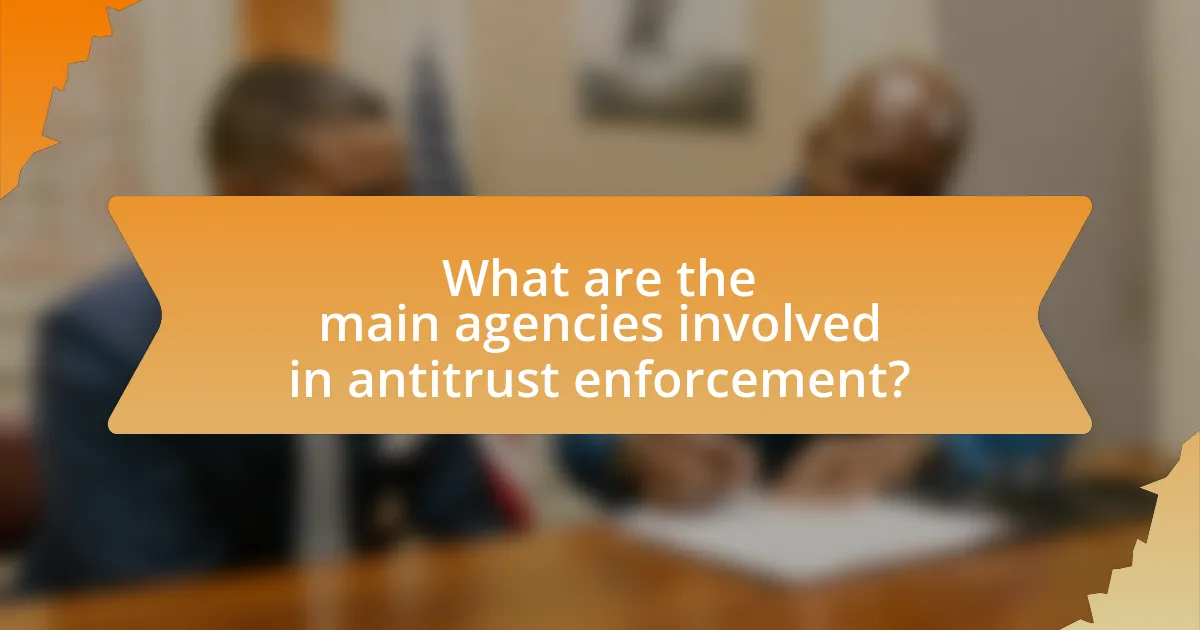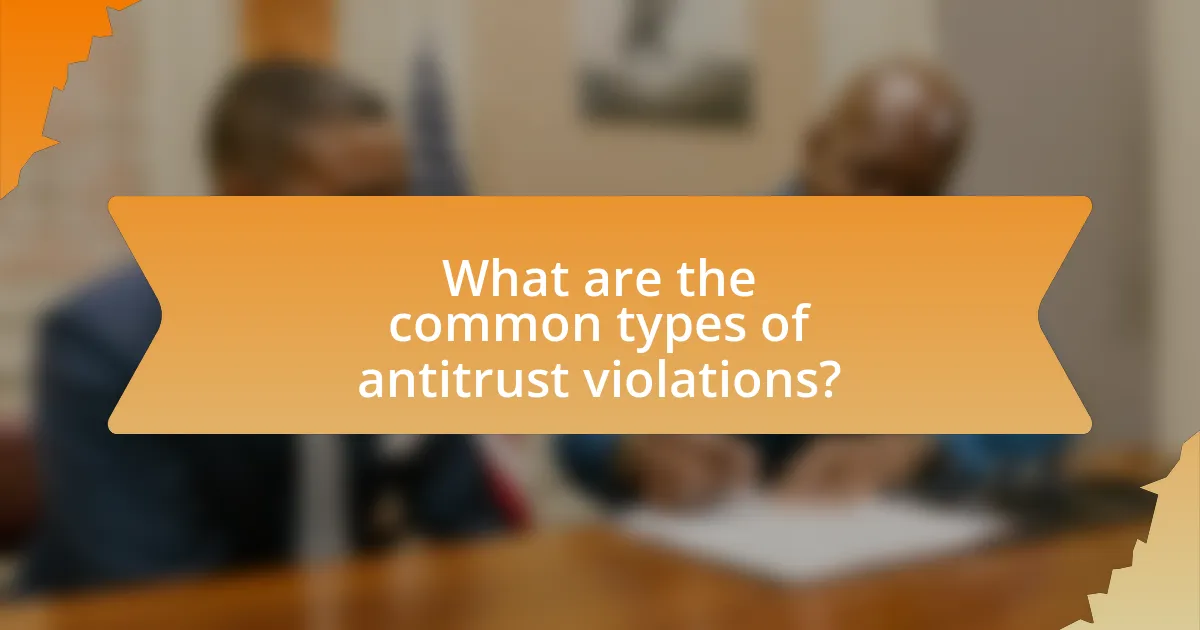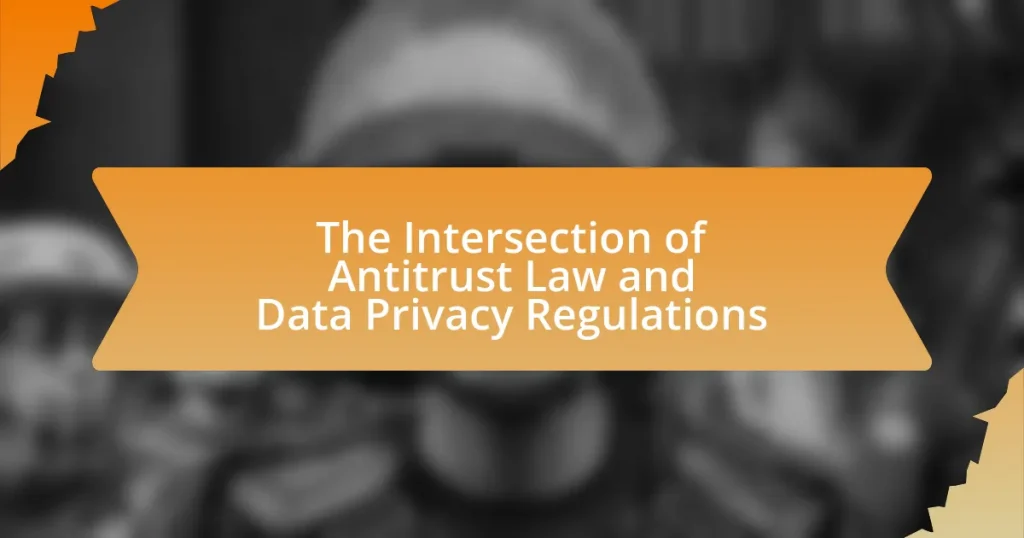The article focuses on the legal framework for antitrust enforcement actions in the United States, primarily governed by the Sherman Act, the Clayton Act, and the Federal Trade Commission Act. It outlines how antitrust law defines anti-competitive behavior, including practices such as price-fixing and monopolization, and discusses the roles of key enforcement agencies like the Federal Trade Commission and the Department of Justice. The article also examines the economic implications of antitrust violations, the processes involved in investigations, and the potential penalties for businesses found in violation of these laws. Additionally, it highlights best practices for companies to ensure compliance with antitrust regulations.

What is the Legal Framework for Antitrust Enforcement Actions?
The legal framework for antitrust enforcement actions in the United States primarily consists of the Sherman Act, the Clayton Act, and the Federal Trade Commission Act. The Sherman Act, enacted in 1890, prohibits monopolistic practices and restraints of trade, while the Clayton Act, passed in 1914, addresses specific practices such as price discrimination and mergers that may substantially lessen competition. The Federal Trade Commission Act, also from 1914, established the Federal Trade Commission (FTC), which enforces antitrust laws and protects consumers from unfair business practices. These statutes collectively provide the basis for federal antitrust enforcement, allowing government agencies to investigate and prosecute anti-competitive behavior.
How does antitrust law define anti-competitive behavior?
Antitrust law defines anti-competitive behavior as actions that unreasonably restrain trade or commerce, leading to reduced competition in the marketplace. This includes practices such as price-fixing, monopolization, and collusion among competitors, which can harm consumers by increasing prices or limiting choices. The Sherman Act of 1890 and the Clayton Act of 1914 serve as foundational statutes in U.S. antitrust law, prohibiting such behaviors to promote fair competition and protect consumer welfare.
What are the key statutes governing antitrust enforcement?
The key statutes governing antitrust enforcement in the United States are the Sherman Act, the Clayton Act, and the Federal Trade Commission Act. The Sherman Act, enacted in 1890, prohibits monopolistic practices and restraints of trade. The Clayton Act, passed in 1914, addresses specific practices that the Sherman Act does not clearly prohibit, such as price discrimination and mergers that may substantially lessen competition. The Federal Trade Commission Act, also established in 1914, created the Federal Trade Commission (FTC) and prohibits unfair methods of competition and deceptive acts or practices. These statutes collectively form the foundation of antitrust law, enabling enforcement against anti-competitive behavior.
How do these statutes apply to different market structures?
Antitrust statutes apply differently across various market structures, primarily influencing competition and market behavior. In perfect competition, these statutes promote fair practices by preventing monopolistic behaviors, ensuring that no single entity can dominate the market. In monopolistic markets, antitrust laws are crucial for breaking up or regulating monopolies to foster competition and protect consumer interests. Oligopolistic structures require careful scrutiny under these statutes to prevent collusion among a few dominant firms, which could lead to price-fixing and reduced consumer choice. Empirical evidence, such as the breakup of AT&T in the 1980s, illustrates how antitrust enforcement can reshape market structures to enhance competition and consumer welfare.
Why is antitrust enforcement important for market competition?
Antitrust enforcement is crucial for market competition because it prevents monopolistic practices and promotes a level playing field for businesses. By regulating anti-competitive behavior, antitrust laws ensure that no single entity can dominate the market, which fosters innovation, lowers prices, and enhances consumer choice. Historical evidence shows that effective antitrust enforcement, such as the breakup of AT&T in the 1980s, led to increased competition in the telecommunications sector, resulting in better services and lower costs for consumers. Thus, antitrust enforcement is essential for maintaining healthy competition and protecting consumer interests in the marketplace.
What are the economic implications of antitrust violations?
Antitrust violations have significant economic implications, primarily leading to reduced competition, higher prices, and decreased innovation. When companies engage in practices such as price-fixing or market allocation, they distort market dynamics, resulting in consumers facing inflated costs for goods and services. For instance, a study by the American Economic Association found that price-fixing can lead to price increases of 20% or more in affected markets. Additionally, reduced competition stifles innovation, as firms may lack the incentive to develop new products or improve existing ones, ultimately hindering economic growth. The overall impact of antitrust violations can lead to market inefficiencies, reduced consumer welfare, and a less dynamic economy.
How does antitrust enforcement protect consumers?
Antitrust enforcement protects consumers by promoting competition and preventing monopolistic practices. This enforcement ensures that no single company can dominate a market, which leads to fair prices, better quality products, and more choices for consumers. For instance, the Sherman Act of 1890 prohibits anti-competitive agreements and monopolization, directly benefiting consumers by maintaining a competitive marketplace. Historical cases, such as the breakup of AT&T in the 1980s, illustrate how antitrust actions can lead to lower prices and improved services for consumers by fostering competition.

What are the main agencies involved in antitrust enforcement?
The main agencies involved in antitrust enforcement in the United States are the Federal Trade Commission (FTC) and the Antitrust Division of the Department of Justice (DOJ). The FTC is responsible for preventing unfair methods of competition and deceptive acts or practices, while the DOJ enforces federal antitrust laws, including the Sherman Act and the Clayton Act. Both agencies work to promote competition and protect consumers from anti-competitive practices, ensuring a fair marketplace.
How do the Federal Trade Commission and the Department of Justice differ in their roles?
The Federal Trade Commission (FTC) and the Department of Justice (DOJ) differ primarily in their enforcement mechanisms and areas of focus regarding antitrust laws. The FTC is an independent agency that primarily investigates and enforces against unfair methods of competition and deceptive practices, while the DOJ is a federal executive department that prosecutes antitrust violations through litigation and criminal enforcement. The FTC can issue administrative complaints and conduct investigations, whereas the DOJ has the authority to file lawsuits in federal court to seek injunctions and penalties against antitrust violations. This distinction is evident in their historical roles, with the FTC established in 1914 to prevent unfair competition and the DOJ enforcing antitrust laws since the Sherman Act of 1890.
What types of cases does each agency typically handle?
The Federal Trade Commission (FTC) typically handles cases related to consumer protection and antitrust violations, focusing on deceptive practices and unfair competition. The Department of Justice (DOJ) primarily addresses criminal antitrust cases, including price-fixing and monopolization, enforcing laws that promote competition. Both agencies collaborate on merger reviews, assessing whether proposed mergers would substantially lessen competition or create a monopoly. The FTC’s authority stems from the Federal Trade Commission Act, while the DOJ operates under the Sherman Act and the Clayton Act, providing a legal framework for their respective enforcement actions.
How do these agencies collaborate on antitrust matters?
Antitrust agencies collaborate through information sharing, joint investigations, and coordinated enforcement actions. For instance, the Federal Trade Commission (FTC) and the Department of Justice (DOJ) often work together to analyze mergers and acquisitions, ensuring compliance with antitrust laws. This collaboration is formalized through the Antitrust Division’s guidelines, which outline procedures for cooperation, including sharing data and resources to enhance the effectiveness of their enforcement efforts. Such collaboration has been evident in high-profile cases, where both agencies have jointly addressed anti-competitive practices, demonstrating their commitment to maintaining market competition.
What are the processes involved in antitrust investigations?
Antitrust investigations involve several key processes, including the initiation of the investigation, data collection, analysis, and potential enforcement actions. Initially, an investigation may be triggered by complaints from competitors, consumers, or through agency monitoring. Following this, regulatory bodies such as the Federal Trade Commission or the Department of Justice collect relevant data, which may include documents, emails, and interviews with industry participants.
After data collection, the analysis phase assesses whether there is sufficient evidence of anti-competitive behavior, such as price-fixing or monopolistic practices. If evidence is found, the agency may proceed with enforcement actions, which can include filing lawsuits or negotiating settlements. Historical context shows that in 2020, the U.S. Department of Justice filed a significant antitrust case against Google, highlighting the rigorous processes involved in such investigations.
What steps are taken during an antitrust investigation?
During an antitrust investigation, several key steps are taken to assess potential violations of competition laws. The process typically begins with the collection of evidence, which may involve reviewing documents, conducting interviews, and gathering data from relevant parties. Following evidence collection, investigators analyze the information to determine if there are sufficient grounds for a violation. If warranted, the investigation may proceed to a formal inquiry, where more extensive data requests and subpoenas can be issued. Ultimately, the findings are compiled into a report that may lead to enforcement actions, such as fines or changes in business practices, if antitrust violations are confirmed. This structured approach ensures a thorough examination of competitive practices and adherence to legal standards.
How do agencies gather evidence for antitrust cases?
Agencies gather evidence for antitrust cases primarily through investigations that include document requests, interviews, and data analysis. These investigations often involve issuing subpoenas to obtain relevant documents from companies, analyzing internal communications, and interviewing employees or industry experts to understand market dynamics. For instance, the Federal Trade Commission (FTC) and the Department of Justice (DOJ) utilize these methods to collect evidence that demonstrates anti-competitive behavior, such as price-fixing or monopolistic practices, which can be substantiated by historical cases like the Microsoft antitrust case in the late 1990s, where extensive documentation and testimony were crucial in establishing the company’s market dominance and anti-competitive actions.

What are the common types of antitrust violations?
Common types of antitrust violations include price fixing, market allocation, bid rigging, and monopolization. Price fixing occurs when competitors agree on prices, undermining free market competition. Market allocation involves competitors dividing markets or customers to limit competition. Bid rigging is when competitors collude to determine the winner of a bidding process, which distorts fair competition. Monopolization refers to a single entity dominating a market, restricting competition and harming consumers. These violations are prohibited under laws such as the Sherman Act and the Clayton Act, which aim to promote fair competition and protect consumer interests.
What constitutes price-fixing and how is it prosecuted?
Price-fixing occurs when competing businesses agree to set prices at a certain level, rather than allowing market forces to determine them. This practice is illegal under antitrust laws, such as the Sherman Act in the United States, which prohibits agreements that restrain trade or commerce. Prosecution of price-fixing typically involves investigations by government agencies, such as the Federal Trade Commission or the Department of Justice, which gather evidence through methods like subpoenas and witness interviews. Successful prosecution can lead to significant penalties, including fines and imprisonment for individuals involved, as demonstrated by cases like the 2012 price-fixing scandal involving major electronics manufacturers, which resulted in over $1 billion in fines.
What are the legal consequences of price-fixing?
Price-fixing is illegal and can lead to severe legal consequences, including substantial fines and imprisonment for individuals involved. Under U.S. antitrust laws, specifically the Sherman Act, companies found guilty of price-fixing can face civil penalties up to $100 million, while individuals may face fines up to $1 million and up to 10 years in prison. Additionally, affected parties can file lawsuits for damages, which can be tripled under the Clayton Act, further emphasizing the financial risks associated with such illegal agreements.
How do agencies detect price-fixing schemes?
Agencies detect price-fixing schemes primarily through data analysis, whistleblower reports, and market surveillance. They analyze pricing patterns and market behavior to identify anomalies that suggest collusion among competitors. For instance, the U.S. Department of Justice employs statistical methods to examine pricing data across industries, looking for consistent price increases that do not correlate with market conditions. Additionally, whistleblower programs incentivize individuals to report suspicious activities, providing agencies with critical insider information. Historical cases, such as the 2012 investigation into the LCD price-fixing conspiracy, demonstrate how these methods lead to successful prosecutions and significant penalties for involved companies.
What is the role of monopolization in antitrust actions?
Monopolization plays a critical role in antitrust actions as it involves the abuse of market power by a single entity to eliminate competition. Antitrust laws, such as the Sherman Act in the United States, specifically target monopolistic practices that harm consumer welfare and stifle innovation. For instance, the Federal Trade Commission and the Department of Justice actively investigate and prosecute cases where companies engage in predatory pricing or exclusive contracts that unfairly limit market access for competitors. Historical cases, such as the breakup of AT&T in the 1980s, illustrate how monopolization can lead to regulatory intervention aimed at restoring competitive markets.
How is monopolization defined under antitrust law?
Monopolization under antitrust law is defined as the acquisition or maintenance of monopoly power in the relevant market through anti-competitive conduct. This definition is rooted in Section 2 of the Sherman Act, which prohibits actions that lead to the establishment or perpetuation of monopoly power. Courts assess monopolization by examining whether a firm has a dominant market share and whether its conduct harms competition, such as through predatory pricing or exclusive contracts. Historical cases, such as United States v. Microsoft Corp., illustrate how monopolization is evaluated based on market power and anti-competitive practices.
What are the defenses against monopolization claims?
Defenses against monopolization claims include demonstrating pro-competitive conduct, showing that the market share is not sufficient to establish monopoly power, and proving that the actions taken were necessary for efficiency or innovation. For instance, a company may argue that its pricing strategies are competitive rather than predatory, or that its market position results from superior products or services rather than anti-competitive practices. Additionally, the “business justification” defense allows a firm to justify its conduct if it can prove that the actions were taken for legitimate business reasons, such as improving efficiency or responding to competition. These defenses are supported by legal precedents, such as the U.S. Supreme Court’s ruling in the case of Verizon Communications Inc. v. Law Offices of Curtis V. Trinko, LLP, which emphasized the importance of competition and the need for firms to engage in aggressive business practices.

How do antitrust enforcement actions impact businesses?
Antitrust enforcement actions significantly impact businesses by promoting competition and preventing monopolistic practices. These actions can lead to substantial fines, changes in business practices, and even the dissolution of companies found to be violating antitrust laws. For instance, in 2020, the U.S. Department of Justice filed a lawsuit against Google, alleging anti-competitive behavior, which could reshape the digital advertising landscape and affect Google’s market strategies. Such enforcement actions not only deter anti-competitive behavior but also encourage businesses to innovate and improve their offerings to remain competitive in the market.
What are the potential penalties for violating antitrust laws?
Violating antitrust laws can result in significant penalties, including substantial fines, imprisonment for individuals, and civil damages. Specifically, corporations may face fines up to $100 million or up to three times the amount of the gain from the violation, whichever is greater. Individuals involved in antitrust violations can be sentenced to up to 10 years in prison. Additionally, victims of antitrust violations may sue for treble damages, which means they can recover three times the amount of their actual damages, plus attorney fees. These penalties are enforced to deter anti-competitive behavior and maintain market integrity.
How do fines and sanctions affect business operations?
Fines and sanctions significantly impact business operations by imposing financial burdens and altering strategic decisions. Businesses facing fines may experience reduced cash flow, which can limit investment in growth initiatives and operational improvements. For instance, the European Commission imposed a €2.4 billion fine on Google in 2017 for antitrust violations, which led to increased scrutiny of its business practices and a shift in its competitive strategies. Additionally, sanctions can damage a company’s reputation, leading to loss of customer trust and potential declines in sales. Research indicates that companies subjected to regulatory penalties often see a drop in stock prices, reflecting investor concerns about future profitability and operational viability.
What are the long-term implications of antitrust violations for companies?
Long-term implications of antitrust violations for companies include significant financial penalties, reputational damage, and operational restrictions. Companies found guilty of antitrust violations may face fines that can reach billions of dollars, as seen in cases like the $5 billion fine imposed on Google in 2018 for antitrust violations related to its advertising practices. Additionally, these companies often suffer from a tarnished public image, leading to decreased consumer trust and potential loss of market share. Operationally, firms may be subjected to increased regulatory scrutiny and restrictions on business practices, which can hinder their ability to innovate and compete effectively in the market. Historical examples, such as the breakup of AT&T in the 1980s, illustrate how antitrust actions can lead to long-lasting structural changes within a company and its industry.
What best practices can businesses adopt to ensure compliance?
Businesses can adopt several best practices to ensure compliance with antitrust laws. First, implementing a robust compliance program that includes regular training for employees on antitrust regulations is essential; this helps to create awareness and understanding of legal obligations. Second, conducting regular audits and assessments of business practices can identify potential compliance risks, allowing for timely corrective actions. Third, establishing clear reporting mechanisms for employees to report suspicious activities without fear of retaliation fosters a culture of transparency. According to the Federal Trade Commission, companies that actively engage in compliance efforts are less likely to face enforcement actions, highlighting the importance of these practices in mitigating legal risks.
How can companies implement effective antitrust compliance programs?
Companies can implement effective antitrust compliance programs by establishing clear policies, conducting regular training, and ensuring ongoing monitoring and enforcement. Clear policies should outline acceptable business practices and the legal implications of antitrust violations, which helps employees understand their responsibilities. Regular training sessions educate employees about antitrust laws and the company’s compliance expectations, fostering a culture of compliance. Ongoing monitoring and enforcement mechanisms, such as audits and reporting systems, ensure adherence to these policies and allow for timely identification and correction of potential violations. These steps are supported by the fact that organizations with robust compliance programs are less likely to face legal challenges, as evidenced by studies showing that proactive compliance reduces the risk of antitrust litigation.
What role does employee training play in preventing violations?
Employee training plays a crucial role in preventing violations by equipping employees with the knowledge and skills necessary to understand and comply with legal regulations. Effective training programs inform employees about antitrust laws, company policies, and the consequences of non-compliance, thereby reducing the likelihood of inadvertent violations. Research indicates that organizations with comprehensive compliance training experience fewer legal infractions, as employees are better prepared to recognize and avoid potentially illegal activities. For instance, a study by the Ethics and Compliance Initiative found that organizations with robust training programs reported a 50% reduction in misconduct incidents.



